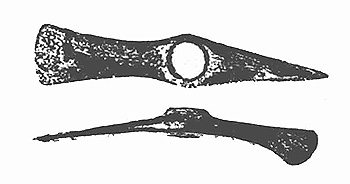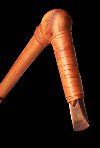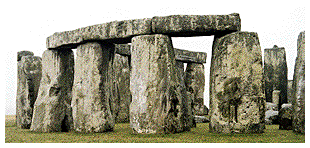Index Dutch Bronze Age
Index first farmers in the Netherlands
Deze pagina is ook in het Nederlands beschikbaar
The prehistory of copper and bronze
(Part 1: Copper)
Part 2: The Early and Middle Bronze Age (especial in the Netherlands)
Part 3: The Late Bronze Age
Part 4: Overview on the Bronze Age
Copper ores are visible on some places in nature. The colour of the ore is blue (azurite) or green (malachite). As a result of erosion the metallic ores can begin to shine, which was noticed by the people back then. They experiment with the blue or green ores, grind it and put it on pottery. During the baking process the ores will melt if temperatures around 1085 0 C are achieved. If not, the rare pigments are exceptional by themselves. This using of the first copper could have started this way. By hammering the metallic (=red shiny) copper and to heat it now and then (250 oC), beads can be produced.
It all began at first in Mesopotamia (Iraque), about 8000 B.C.E.! Later, about the
5th millenium
B.C.E., people started to smelt the copper in small quantities in Central Turkey.
The techniques developed, knowledge was spread and soon beads, pins and piercers, made from the shiny metal,
were common throughout the Middle East.
There are many advantages of copper, compared with stone and other materials:
- it shines in a unique way
- it's rare, so posessing copper gives consideration
- when it breaks down, it can be re-melted
- it's easy to forge, to harden (hammering) and to soften (re - heating)
- it's easy to sharpen
- after a while it's colour is changing into blue - green
- when the smiths learned to cast it into a mould, the possibilities enlarged.
Image: The oldest coppermines

In the Balkan miners dig the ores around 4800 B.C.E. on a big scale. They dig pits and follow the
layers of the ores.
In Serbia 20 shafts were discovered and miners worked probably according to the following
procedure:
- a fire is placed against the wall of the pit with the ores
- cold water splits the hot rocks and the ores can be taken out
- after grinding, cleaning and smelting, the pure copper can be cast into sandstone moulds
The finding of a combined adze / axe including a casted hole for the handle shows the great available technical knowledge in the Balkan back then.
Vidra-type axe with casted socket. Gumelnitza-culture (during late Vinca phase), lower Danube, 5th millenium B.C.E.. Ashmolean museum, Oxford, UK.

The mining of the ores spreads also over the rest of Europe.
The glacier man "Ítzi" carried
with him a beautiful 99,7% pure copper axe (with arsen?) around 3300 B.C.E. (watch below)

About 1000 years later ancient Portugese people dig mines and cast axes, knifes, saws,
chisels and piercers.
In the Netherlands the oldest copper comes from a Dutch megalith ('hunebed') near Buinen
(Drenthe). These spiral beads, about 9 cm. long, were made around 2500 B.C.E. but the hunebeds
are older: 3500 B.C.E. - 2900 B.C.E.
Later copper daggers and various piercers were put in graves from the Bell beaker folk in
the center part of the Netherlands as well in its south-west. In some of these graves (Lunteren,
Susteren) some square stone anvils were placed. So one can say that the Bell beaker people
were the first copper smiths in the Netherlands.
The copper was imported, because there are no copper ores in the Dutch soils. But from where,
by whom and where the copper came from, stays unsure.
Since the smiths came from a neoltihic society, it's not strange that the copper tongue-
shaped daggers (sometimes called "Ciempozuelos") look like their flint
precursors.
Another, striking, detail is that the copper in many cases contained the poisonous
arsen, which hardens it. So selected copper ores, enriched with arsen were used. Maybe the miners /
smiths even added arsen to the copper themselves...
The smith probably didn't live long because of the arsenic vapours.
(Latest news: according to new experiments the arsen remains mostly in the copper during the melting process)
Adding tin (instead of arsen) to the copper also produced a harder copper, but the smith lived
longer and a new period started: the Bronze Age.
(Watch literature sources)
Part 2: The Early and Middle Bronze Age
In Syria there are 2 rivers, which contain copper ore as well as tin ore ("cassiterite"). When the copper was "mined",
it could have been mixed with the tin ore by accident, so it produced a harder kind of copper, called "Asian copper".
This term appears in Egyptian texts around 2500 B.C.E. and means probably "bronze".
But tin ores are very rare in nature; and soon traders spread all over Europe to seek the new ore.
By mixing 90 % copper with 10 % tin the result becomes about 2 times as hard as pure copper! Finally traders found in
Southwest England what they were looking for, and soon they dug mines that brought prosperity and wealth to the
native population. Stonehenge dates partly from that period (1700 B.C.E.) and lies in the same area. There has been discovered cuprous
oxide under one of its giant stones.
Pythias, a Greek traveller, wrote about the Cornwall tin:
"The tin traders at Land's End in Cornwall.... win tin by handling the ore with great knowledge. They than cast it in cubics and bring it to an island just offshore called 'Ictus'. Foreign traders buy it there to bring it to Gaul"
The fact, that foreign traders also visited the Netherlands can be proofed by the various "foreign" findings: tin beads from Cornwall, fayence beads from Egypt (!), amber from Denmark and of course copper and bronze from Germany, Ireland, Austria and Bohemia.
Right: Stonehenge, U.K., Early Bronze Age.

The exact dating of the beginning of the Bronze Age isn't 100 % sure. It has been estimated that it all began
between 2200 B.C.E. and 1800 B.C.E. Let's look at the most interesting findings.
(watch pictures)
- The grave of the "Smith from
Wageningen" around 1800 B.C.E.
A flat bronze axe, a stone axe, a halberd, they're typical items from the Early Bronze Age in the Netherlands.
The half finished items (bronze bracelets) point to a smith.
The puzzle in this finding is, that the shapes indicate an Irish origine, while the bronze came from Germany (an itinerant smith?) - The chief of Drouwen ("Drenthe"), about 1800 B.C.E.
This grave contained a North-German sword ("S÷gel / Wohlde") , an axe, a "British" rasor, flint arrow points, gold spiral earrings and a flint "firestone"
Part 3: The Late Bronze Age
This part shows the further developement in using copper and bronze.
The Late Bronze Age in the Netherlands goes from about 1100 B.C.E. to 800 or 700 B.C.E.
The most important difference between this period and previous periods is the sudden cremation of the dead, in stead of the burials.
That's why archaeologists call this period sometimes "urnfield period".
Qua bronze: since the Middle Bronze Age the forgers add traces of lead to the bronze so details of the moulds are better visible in the results.
From this period hugh amounts of artifacts (19,000!) were discovered in and near an Austrian salt mine in Hallstatt.
It lookes like this area ("Salzkammergut" near Salzburg) had an enourmous influence on the rest of Europe, partly because of the salt that had been distributed there.
And of course the wealth that was brought by the salt.
There were also many copper mines near Hallstatt. In the literature one can often read about "Hallstatt A" or "B" which means the Centraleuropean, late, Bronze Age.
In the Netherlands a whole new design of artifacts developes, that I would even call "revolutionair".
The casters change the design of axes and knifes; they receive a socket which then contains the handle.
The advantage is evident; one needs less bronze for the result, although it's harder to cast a good item.
The idea of a socket probably was created by the hollow spear-heads, which already existed since the Middle Bronze Age, including a drilled or punched hole for a nail.
About 150 spear-heads have been found for so far, just in the Netherlands.
Also knifes receive a socket and the additional name: "Urnfield knifes".
They are very common in the western regions of Central Europe.

Knifes from the same period but looking different are rare; they have a massive bronze, T-shaped handle and are often decorated very beautiful. From the 10 knifes found until now,
5 were found in the northern part of the Netherlands.(watch drawings below right)
In North England even a socketed bronze sword was found, also dating from this period.
The most interesting about this finding is the artifact that was found nearby; an also hollow casted,
antenna-like (so typical Celtic!), decorated handle. On this handle even soldering-techniques were to be seen!
Since about 2500 B.C.E., in the Middle East casters used the lost-wax method to produce the moulds.
From about 1500 B.C.E. on, this technique also appears in West Europe. Using this technique
it is even possible to cast clothing pins with a hollow knob including a small pebble which
makes a rattling sound when it's moved.
The length of these pins could be from 28 to even over 52 cm.! (Oosterhout, Late Bronze Age)
By the way, this part of the Bronze Age appears to be a part with "large findings":
- spear-heads from 20 - 39 cm (Belgium) to even 47.5 cm (Tollebeek, near Urk, The Netherlands 1500 - 1000 B.C.E.)
- Scandinavian type clothing pins shaped like and as big as spectacles.(Gasselte, Noordwijkerhout)
- 2.2 kg heavy, thick, not usable, "swords" (Jutphaas -watch image right- ; Ommerschans)
- also unpractical heavy axes (Denmark, 28 x 14 cm)
- a large, bowl shaped, belt decoration (diameter 20 cm, "Princess of Drouwen", 8th century B.C.E.)
Technically, the casters also work on a much bigger scale:
- in Greece, from 1200 B.C.E. on, crucibles with a diameter from 30 - 40 cm were used, in which many kilo's could be melted in one casting (statues!)
- in the eastern part of Germany (Dresden) a dome-shaped copper-oven has been discovered (5 m diameter, 4 m high) with a natural air passage from about 18 m long.

Around 900 B.C.E., armours are improved: cuirasses, bronze shields, swords, but not in the Netherlands. Even cuirasses for women have been found (France), so probably some women took also part in the battle. A couple of hundreds of years later in Gaul women took part in a special way: they showed their breasts while their city (Gergovia) was besieged by the Romans. And Boudicca (50 B.C.E.) was a famous female warrior in Britannia.
In the Netherlands, region Nijmegen / Roermond, only 2 types of weapons were discovered: swords and spear-heads. From the Middle Bronze Age on they were deposited in the rivers in large amounts, but the reason why isn't sure.
Near Roermond even 10 Late Bronze Age swords were dredged from the river Meuse. Another beautiful
sword comes from Bergeijk.
The most swords weren't found near -well dated- pottery, so it's hard to put dates to these findings.
Around 800 B.C.E. the (mostly Northern) Dutch bronze industry developes enriched decorations and
an improvement of existing forms:
- "T-knifes" (watch drawings right)
- socketed axes with "winged" decoration (8th century B.C.E.)
- bracelets with ribs (Drouwen, Late Bronze Age)
In the southern part of the Netherlands the oldest prooves of local bronze-industries from Berg-en-Terblijt, Limburg (8th century B.C.E.). A smith had burried his stock there: an "edged" axe, a socketed axe and a sickle with small knobs to attach to a handle.
The common use of iron ended the Bronze Age (about 8th century B.C.E.), but certainly not the fabrication of bronze objects.
Part 4: The Bronze Age (overview)
This part overviews the parts 1 to 3, so the era until the 8th century B.C.E., but only in the Netherlands
| Period / culture: | Estimated years B.C.E.: | Characteristics: |
| Bell Beaker | 2500 - 2000 | first copper, daggers, beads, arsen copper |
| Early Bronze Age | 2000 - 1800 | flat axes, daggers, copper with 6-12 % tin |
| Middle Bronze Age | 1800 - 1100 | long daggers without handle, copper with ▒ 10 % tin, bracelets, edged axes, the first short swords, hollow spear-heads with a small hole, socketed axes with or without an "ear" |
| Late Bronze Age / "Urnfields" / Hallstatt A and Hallstatt B | 1100 - 800 | edged axes, winged axes, socketed axes, swords with an "angle" or with cast handle, socketed knifes, "spectacle-" fibulae, bracelets with ribs |
More information about the glacier man's body can be read here -ook in het Nederlands .
Deze pagina over koper is ook in het Nederlands beschikbaar
More info about the writer / editor